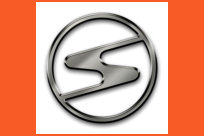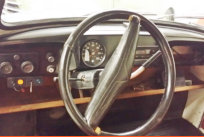


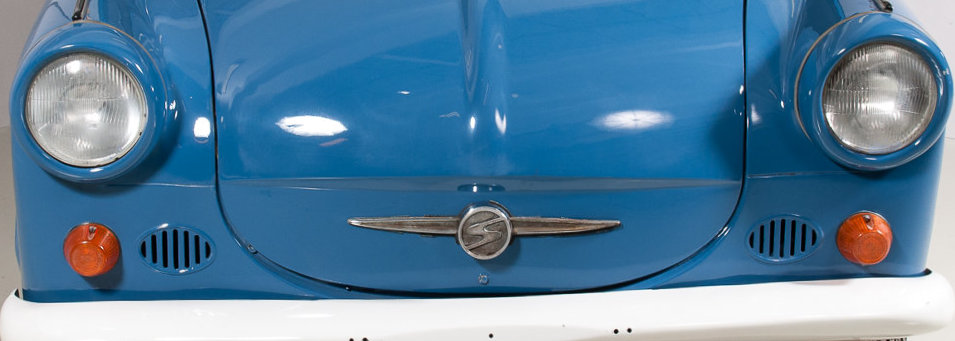

Production of the Trabant reached 3.7 million vehicles on 30 April 1991

Trabant P 50 - 1961
The Trabant is a car that was produced by former East
German auto maker VEB Sachsenring Automobilwerke
Zwickau in Zwickau, Saxony. It was the most common
vehicle in East Germany, and was also exported to
countries both inside and outside the Eastern Bloc. It was
advertised as having room for four adults and luggage in a
compact and durable shell; and being relatively fast.
Due to its poor performance, outdated and inefficient two-stroke engine (which produced poor fuel economy and smoky exhaust), and production shortages, the Trabant was regarded with derisive affection as a symbol of the extinct former East Germany and of the fall of the Eastern Bloc. This is due to the fact that in former West Germany, many East Germans streamed into West Berlin and West Germany in their Trabants after the opening of the Berlin Wall in 1989. It was produced for nearly 30 years with almost no significant changes; 3,096,099 Trabants were produced in total. In Western nations, the Trabant's shortcomings are written about to great extent for comedic effect. However, the Trabant, in some cases, has become trendy for collectors to import older models to the US due to their low cost and easier import restrictions on antique vehicles.Overview
Meaning "satellite" or "companion" in German, the name was inspired by Soviet Sputnik. The cars are often referred to as the Trabbi or Trabi. Due to the long waiting period between ordering a Trabant and actual delivery (in some cases, years), used Trabants would fetch higher prices than new ones. The people who finally received their own Trabant treated the car gently and were meticulous in maintaining and repairing it. The lifespan of an average Trabant was 28 years. There were four principal variants of the Trabant: • the P50, also known as the Trabant 500, produced 1957–1962 • the Trabant 600, produced 1962–1964 • the Trabant 601, produced 1963–1991 • the Trabant 1.1, produced 1990–1991 with a 1,043 cc (63.6 cu in) VW engine (making the "1.1" a slight misnomer) The engine for the 500, 600, and original 601 was a small two-stroke engine with two cylinders, giving the vehicle modest performance. Its curb weight was (~600 kg / 1100 pounds). At the end of production in 1989, the Trabant delivered 19 kW (26 horsepower) from a 600 cc (37 cu in) displacement. It took 21 seconds to accelerate from 100 km/h (60 mph) and had a top speed of 100 km/h (62 mph). There were two main problems with the engine: the smoky exhaust and the pollution it produced – nine times the hydrocarbons and five times the carbon monoxide emissions of the average European car of 2007. The fuel consumption was 7 l/100 km (40 mpg-imp; 34 mpg-US). Since the engine did not have an oil injection system, two-stroke oil had to be added to the 24- litre (6.3 U.S. gal; 5.3 imp gal) fuel tank every time the car was filled up, at a 50:1 or 33:1 ratio of fuel to oil. Gas stations of the time, in countries where two-stroke engines were common, served premixed gas-oil mixture from the pump. Today, owners carry a container of two-stroke oil in the car for this purpose. Because the car lacked a fuel pump, the fuel tank had to be placed above the motor in the engine compartment so that fuel could be fed to the carburetor by gravity; a trade-off of this design was an increased fire risk in front-end accidents. Earlier models had no fuel gauge; a dipstick was inserted into the tank to determine how much fuel remained. The Trabant was a steel monocoque design with the roof, trunk lid, hood, fenders, and doors made of Duroplast. Duroplast was a hard plastic (similar to Bakelite) made of recycled materials: cotton waste from the Soviet Union and phenol resins from the East German dye industry. This made the Trabant the first car with a body made of recycled material and was partially responsible for the misconception that it was made of cardboard. The Trabant was the second car to use Duroplast, after the "pre-Trabant" P70 (Zwickau) model (1954–1959).History & Origins
The Trabant was the result of a planning process that had originally intended to design a three- wheeled motorcycle. In German, a Trabant is an astronomical term to denote a moon or other natural satellite of a celestial body. In its Slavic origin, Trabant has the same meaning as the Russian word sputnik, namely 'companion'.Full production
The first of the Trabants left the factory of the VEB Sachsenring Automobilwerke Zwickau in Saxony on 7 November 1957. The Trabant was a relatively advanced car when it was launched in 1958, with front wheel drive, a unitary construction, composite bodywork, and independent suspension. Its greatest downfall was its engine: by the late 1950s many small cars in western countries already used cleaner and more efficient four-stroke engines like that in the Renault. Budgetary constraints and raw materials shortages forced the use of an outdated but inexpensive two-stroke engine in the Trabant. When released, the Trabant was technically equivalent to the West German Lloyd automobile, which had an air cooled two-cylinder four- stroke engine in a similarly sized vehicle. The Trabant's air-cooled two cylinder 500 cc (31 cu in) (which was eventually upgraded to 600cc) two-stroke engine was derived from a pre-war DKW design, with minor alterations being made throughout the car's production run. The first Saab car had a larger (764 cc), water cooled, two cylinder engine. Wartburg, a GDR manufacturer of larger saloons, also used a DKW engine: a water-cooled three cylinder 1,000 cc (61 cu in) two-stroke unit. 1958 marked the production of the original Trabant, the P50. This car was the base model of the Trabant series, and even the latest 1.1s shared a large number of interchangeable parts. The 500 cc 18 hp (13 kW) P50 evolved into a 20 hp (15 kW) version in 1960, gaining a fully synchronized gearbox amongst other things, and finally got a 23 hp 600 cc engine in 1962, becoming the P60. The updated P601 was introduced in 1964. This car was essentially a facelift of the P60, with a different front fascia, bonnet, roof, and rear, whilst retaining the original P50 underpinnings. This model stayed practically unchanged up to its production end, with the most major changes being 12v electronics, coil springs for the rear, and a different dash for the latest models. The Trabant's designers expected production to extend to 1967 at the latest, and East German designers and engineers created a series of more sophisticated prototypes through the years that were intended to replace the Trabant P601; several of these can be seen at the Dresden Transport Museum. However, each proposal for a new model was rejected by the GDR leadership due to constant shortages of critical raw materials, which were required in larger quantities for the more advanced designs. As a result, the Trabant remained in production largely unchanged.Late production (1989–1991)
Starting in the summer of 1989, thousands of East Germans loaded their Trabants with as much as they could carry and drove to either Hungary or Czechoslovakia en route to West Germany. Many of them had to get special dispensation to drive their Trabants into West Germany, as many of them failed to meet West German emissions standards (their pollution was four times the European average). In 1989, a licensed version of the Volkswagen Polo engine replaced the ancient two-stroke engine, the result of a trade agreement between the two German states. The model, known as the Trabant 1.1, also had minor improvements to the brake and signal lights, a revised grille, and MacPherson struts instead of the leaf spring-suspended chassis. However, by the time it entered production in May 1990, the two states had already agreed to reunification. It soon became apparent that there was no place for the Trabant in the reunified German economy. The inefficient, labour-intensive production line was kept open only because of government subsidies. Demand plummeted as residents of East Germany preferred second-hand western cars which were more efficient and produced less pollution. The Trabant production line closed in 1991 and the factory in Mosel (Zwickau), where the Trabant 1.1 was produced, was sold to Volkswagen AG - a move that was seen as ironic given that Volkswagen owns Audi (formerly Auto Union) - which was the original owner of the factory before it was forcibly wound up by the Soviet regime and its directors forced to flee to the West, where the company was re-founded in its current home in Ingolstadt, Bavaria. The rest of the Trabant company became HQM Sachsenring GmbH. Volkswagen has now substantially redeveloped the Zwickau site, which now is a centre for engine production, as well as small scale production of the Golf and Passat.1990s and beyond
Trabants became well known in the West after the fall of the Berlin Wall when many were abandoned by their Eastern owners after migrating westward. However, unlike many other Eastern European cars of the eastern bloc era – notably the Lada Niva, Škoda Estelle, Polski Fiat, and Yugo – the Trabant was not a strong seller in Western Europe. In the early 1990s it was possible to buy a Trabant for as little as a few Deutsche Marks, and many were given away. Later, as they became collectors' items, prices recovered, but remain very cheap cars to this day. The popular culture surrounding the Trabant was referenced by the performance artist Liz Cohen in her Bodywork project, which transformed an East German 1987 Trabant into a 1973 Chevrolet El Camino. In the late 1990s, there were plans to put the Trabant back into production in Uzbekistan as the Olimp.; only a single model was produced. Former Bulgarian Foreign Minister and Atlantic Club of Bulgaria founding president Solomon Passy owned a famous Trabant, which he used to take NATO Secretaries General Manfred Wörner, George Robertson, and Jaap de Hoop Scheffer for a ride. Passy's Trabant was also blessed by Pope John Paul II in 2002. In 2005, Passy donated the vehicle, which had become a symbol of Bulgaria's NATO accession, to the National Historical Museum of Bulgaria. In 1997, the Trabant was celebrated for passing the "Elchtest" ("moose test"), a 60 km/h (37 mph) swerve maneuver slalom, without toppling over as the Mercedes-Benz W168 (1997 A-class) infamously did. A newspaper from Thuringia had a headline saying "Come and get us, moose! Trabi passes A-Class killer test". In 2007 the Trabant was brought into the world of diplomacy. Steven Fisher, the Deputy Head of Mission in the British Embassy in Budapest uses a P50 – painted as close to British Racing Green as possible – as his diplomatic car. American Trabant owners celebrate the fall of the Berlin Wall with an annual rally in the U.S. capital city of Washington, D.C. called the "Parade of Trabants." The free event, which is sponsored by the International Spy Museum, includes street-side tours in Trabants, rides, live German music, and displays about East Germany is held in early November. In recent years more Trabants are being imported into Canada and the US. A recent auction from the Bruce Weiner Microcar Museum in Madison, Georgia saw a Trabant P50 and matching Wohnwagen (camper trailer) fetch ~US$25,000. An online forum, TrabantForums.com was launched in 2011 that allows the English speaking Trabant owners to share information, knowledge, parts and experience.
1961
Engine 600 cc 2 cylinders 2 stroke Lenght/width 3,36 m/1,5 m
Photos mainly by Matti Kreivilä. Historical facts and technical details of the vehicles provided by Wikipedia. Movies YouTube.
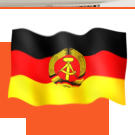
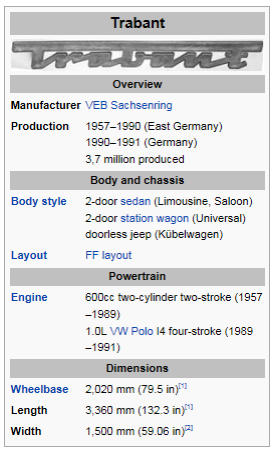


- Autobianchi Transformable - 1960
- Autobianchi Familiare - 1962
- Autobianchi Panoramica - 1962
- Autobianchi Cabriolet - 1963
- BMW Isetta 300 - 1956
- BMW Isetta 300 - 1959
- BMW Isetta Standard
- BMW 600 - 1959
- Bond Bug ES 700 - 1973
- Fiat Topolino - 1936
- Fiat Topolino - 1939
- Fiat Topolino - 1951
- Fiat Belvedere - 1952
- Fiat Topolino - 1954
- Fiat 600 - 1955
- Fiat 500 - 1963
- Fiat 500 - 1969
- Fiat Multipla - 1965
- Fuldamobil 4-wheel - 1958
- Fuldamobil King S7 - 1959
- GLAS Isar T700 - 1962
- Goggomobil T400 - 1959
- Goggomobil T250 - 1961
- Goggomobil T250 - 1969
- Goggomobil Coupe
- Heinkel Kabine - 1959
- Honda N600 - 1970
- Jalta Saporoshez - 1967
- Lloyd Alexander TS - 1960
- Messerschmitt KR200 - 1960
- Messerschmitt KR201
- Messerschmitt KR200 - 1963
- Messerschmitt KR200 - 1964
- NSU Prinz I - 1958
- Scootacar Mk3 - 1963
- Steyr-Puch 500 -1961
- Steyr-Puch 650 - 1964
- Trabant P 50 - 1961
- Trojan 603/198 - 1964
- Trojan 3-wheeler - 1964
- Trojan 3-wheeler - 1964
- Vespa 400 - 1959
- Victoria Spatz 250 - 1957
- ZŁndapp Janus - 1959


- About Scooters
- Apollo moped
- Cezeta 175 - 1960
- Heinkel Tourist - 1960
- Lambretta 125 - 1953
- Puch SR 150 - 1958
- Pyrkijš moped
- Suzuki Burgman 400
- Tunturi City - 1980
- Vespa 150 - 1959
- Yamaha Passola 50 - 1980
- ZŁndapp Bella w. sidecar - 1960
- ZŁndapp Bella 204 - 1960
- ZŁndapp Bella 200 Deluxe - 1963
- ZŁndapp Combinette

